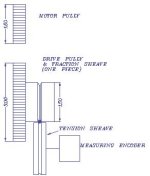Originally posted by rsdoranIf the customer is agreeable to using surplus items in the design you may be able to offer more system for the same money.
I'll admit, that's an idea I hadn't considered. But I'm a reluctant to go that route on this particular project. Control systems (for the time being, at least) are not my forte, and I feel like I need every break I can get as far as support from the manufacturer goes. You more experienced types are probably in a better position to take advantage of surplus stuff.
The Oriental stepper motors I used to work with were the 5-phase that included an encoder. These were overall reliable units but I can state don't cheat on the wire (go too small) especially if the units are not stationary. These units were very precise in positioning.
I have to say I'm also kind of impressed with Oriental Motor. I saw one of their ads in Machine Design, and must have circled their number on one of those literature-request cards. I usually do this if I'm only mildly interested in their ad, as there seems to be about a 1 in 10 shot of them responding. Well, they responded by sending me a copy of their 2" thick catalog -- very impressive and well-documented. Not long after, I got a call from one of their sales technicians asking if I needed any help with an application. Though I haven't priced any of their stuff yet, my guess is that's where the trade-off is. Looks like they really have their act together, though.
I did some work for a company that made threaded rods... I cannot remember the company names of the machines that cut the wire prior to threading tho. I noticed that this company, http://www.threadedrod.com/index.php also makes threaded rod if the process is similar and you could get a tour you may get some more ideas.
Actually, this place is not far from where I live.
The machines I remember used regular AC drives with feedback from a counter or encoder and brakes to do a feed to length then cut style system.
This is the approach that Mike was discussing yesterday, and it looks like it might work well for a machine like this. I wasn't even thinking of an alternative to the stepper. I didn't realize how much you could do with an inverter these days. Arik suggested a Yaskawa J7, which is a nice-looking little unit. I haven't a clue how to interface on of these with a PLC, however.
Sounds like it may be possible to use a simple DC motor or gear motor with a controller that could accept a 0-10vdc speed reference from an analog output. Simple inexpensive option that wouldnt hurt to look at...
I wonder about this too. Really, as long as one monitors the actual wire travel with an encoder, just about any motor that can stop predictably and be controlled from the PLC is worth considering. My problem is I don't have a great deal of experience with most of them. I've been studying up on steppers for a month or more now, and I may wind up going that route just by default, and the need to make
some kind of decision.






